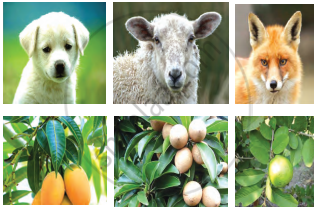Advertisements
Advertisements
प्रश्न
Give two examples of vestigial organs in human beings and plants.
उत्तर
Vestigial organs are remains of a structure that were functional in some ancestor but is no longer functional in present body.
Some examples of such organs in humans are:
(a) Appendix: The appendix is a small projection of the side of the large intestine near the cecum. It looks kind of like a tail and is found near where the small and large intestines meet. No one knows the actual original function of the appendix.
(b) The tail bone: Attached to the bottom of the sacrum is the coccyx or tailbone. This small, bony projection seems to be a leftover structure of primate evolution. It is believed that human ancestors once had tails and lived in trees. The coccyx would be where the tail was attached to the skeleton.
Some examples of such organs in plants are:
(1) Sexual organs of dandelions: The common dandelion reproduces asexually through a process known as apomixis. However, they still have all of the functional parts that most flowering plants use to reproduce sexually, namely the stamen and pistil.
(2) Grass often has small, undeveloped structures that strongly resemble those of flowering plants.
APPEARS IN
संबंधित प्रश्न
(a) Select the analogous structures from the combination given below:
(i) Forelimbs of whales and bats
(ii) Eyes of octopus and mammals
(iii) Tuber of sweet potato and potato
(iv) Tuber of Bougainvillea and tendrils of Cucurbita
(b) State the kind of evolution they represent
Explain with an example for the given, how the following provides evidence in favor of evolution in organisms :
Homologous organs
“Two areas of study namely 'evolution' and 'classification' are interlinked'. Justify this statement.
If you are asked to select a group of two vegetables, out of the following, having homologous structures which one would you select?
(a) Carrot and radish
(b) Potato and sweet potato
(c) Potato and tomato
(d) Lady finger and potato
Explain with an example for the given, how the following provides evidence in favor of evolution in organisms :
Fossils
There are five animals A, B, C, D and E. The animal A uses its modified forelimbs for flying. The animal B uses its forelimbs for running whereas the animal C uses its forelimbs for grasping. The animal D can live on land as well as in water and uses its forelimbs to prop up the front end of its body when at rest. The animal E which respires by using spiracles and tracheae uses wings for flying but its wings are analogous to the modified forelimbs of animal A.
(a) What could the animals A, B, C, D and E be?
(b) Why are the forelimbs of animals A, B, C, D called homologous organs?
(c) What does the existence of homologous organs in animals A, B, C and D tell us about their ancestors ?
(d) Why are the modified forelimbs of animal A and the wings of animal E called analogous organs?
(e) State whether animals A and E have a common ancestor or not.
Identify the following pairs as homologous and analogous organs:
(i) Sweet potato and potato
(ii) Eye of octopus and eye of mammals
(iii) Thorns of Bougainvillaea and tendrils of Cucurbits
(iv) Fore limbs of bat and whale
You have potato, carrot, radish, sweet potato, tomato and ginger bought from the market in your jute bag. Identify two vegetables to represent the correct homologous structures.
(A) Potato and tomato
(B) Carrot and tomato
(C) Potato and sweet potato
(D) Carrot and radish
Write short notes based upon the information known to you.
Embryology
“Appearance of melanised moths post-industrialisation in England is a classic example of evolution by natural selection.” Explain.
With the help of diagrams, describe emasculation and bagging.
Choose the correct option of the following question:
Wings of Insect and Birds are examples of :
Explain any three molecular (genetic) evidences in favour of organic evolution.
Long answer question.
Would you consider wings of butterfly and bat as homologous or analogous and why?
Find an odd one out.
Give scientific reason.
Peripatus is said to be the connecting link between Annelida and Arthropoda.
Define the evidence of evolution shown in the figure.

What is carbon dating?
Observe the given images and answer the following questions.

- Which evolutionary evidence does it indicate?
- What does it prove?
- State another example of evolutionary evidence.
Which evidence of evolution is shown in the given picture? Explain the importance of this evidence.

The degenerated and non-functional organs found in an organism are called ______.
Which of these is not a vestigial organ in human beings?
- Define vestigial organs.
- Write names of any two vestigial organs in the human body.
- Write name of those animals in which these vestigial organs are functional.
Homologous organs are:
The presence of gill slits, in the embryos of all vertebrates, supports the theory of ______.
The study of fossil evidence of evolution is called ______
Animal husbandry and plant breeding programmes are the examples of ______.
The bones of forelimbs of whale, bat, cheetah and man are similar in structure, because ______.
Analogous organs arise due to ______.
What were the characteristics of life forms that had been fossilised?
How do we compute the age of a fossil?
Explain divergent evolution in detail. What is the driving force behind it?
Complete the following diagram:

Write down the difference between homologous and analogous organs.
Find the odd one out:
Evolutionary convergence is the development of a ______.
